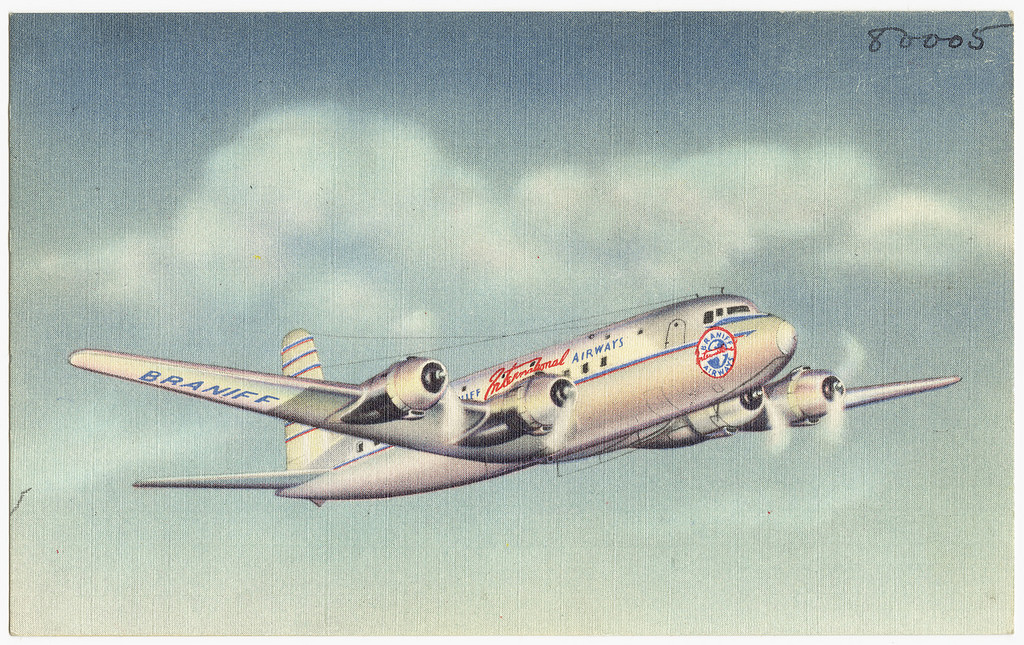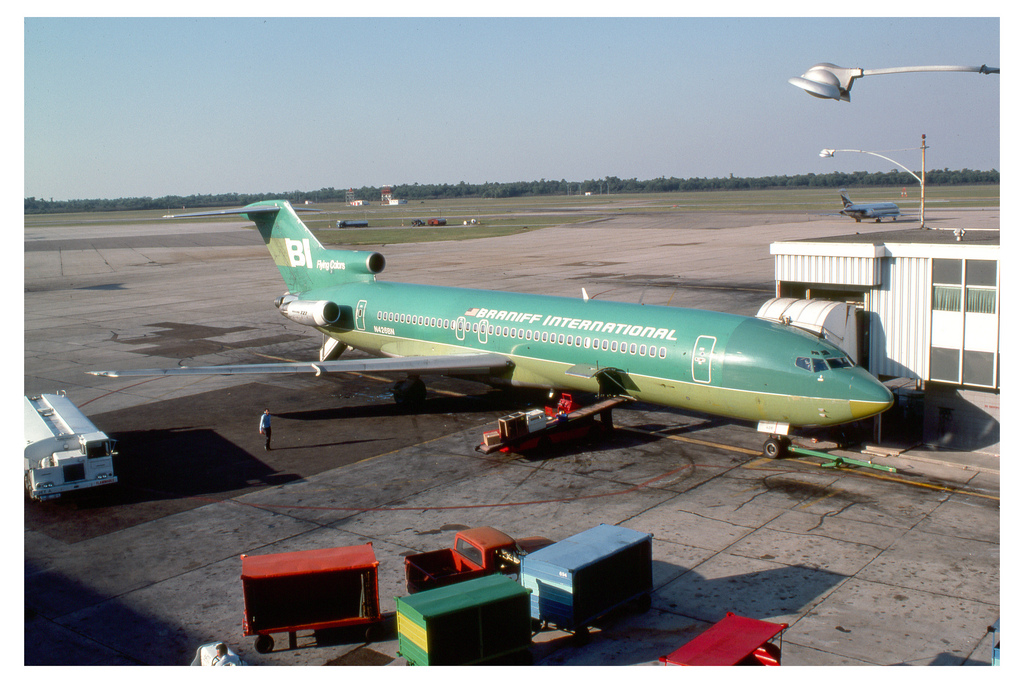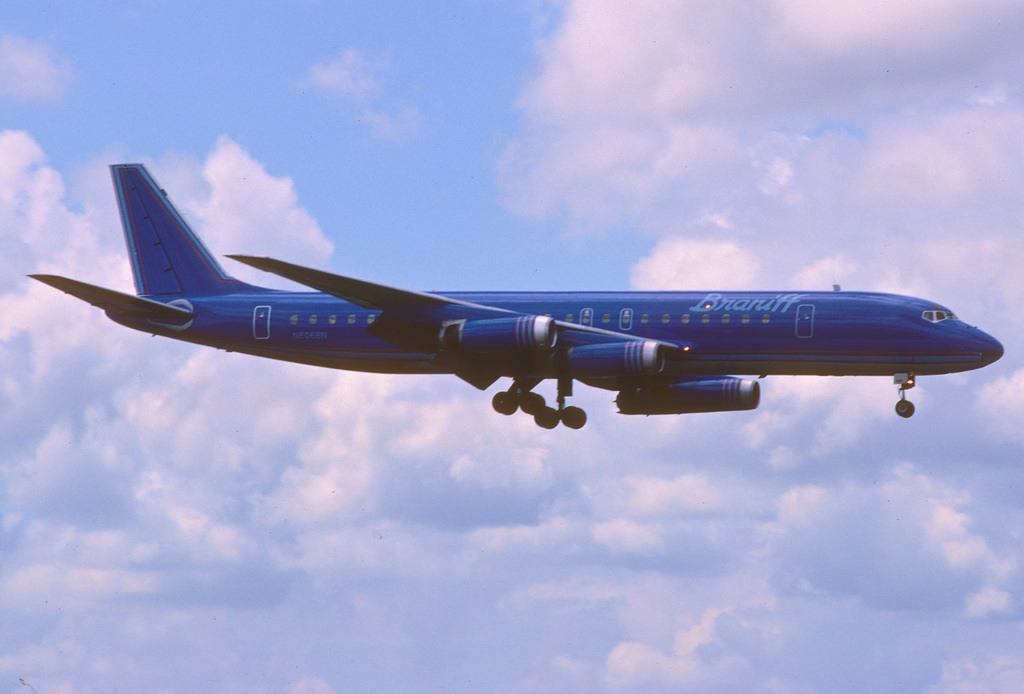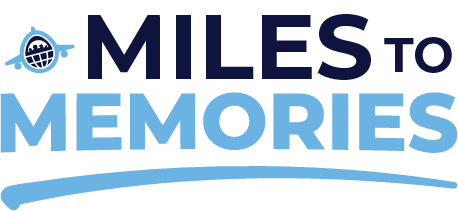

Today Senior Contributor R.D. Sussmann-Dewberry returns with part 2 of his stellar three part series on the history of Braniff International. He has previously written fantastic pieces about the modern rise of Delta, the new American Airlines, the History of Low Cost Carriers, United Airlines, the History of Air Shuttles, The Middle East 3, Alaska’s purchase of Virgin America, United’s Polaris and Slim Line Seats. He has been involved with the airline industry for over 20 years and is an active travel consultant and airline analyst. R.D. is also a huge #Avgeek, a theme park enthusiast and a friend.
Navigation:
- Part I: Braniff – from Stinsons to Flying Colors
- Part II: Braniff – Ultra Colors, ultra problems.
- Part III: Braniff – Those who do not learn from the past are doomed to repeat it
Part II: Braniff – Ultra Colors, ultra problems.
1977 introduced the Ultra look (Though referred to as ‘the new look’ internally) to Braniff’s colorful fleet. Five solid hue planes with accessory stripes began to grace the airways, and Halston uniforms & interiors were added. Braniff was a success story on a very large scale, with high yields, good loads & a steady track record of solid profits. Where the rest of the industry was righting itself after six years of financial turbulence, Braniff’s success was ongoing.
In 1977, a bill was introduced to the House by Dr. Alfred E Kahn, head of the Civil Aeronautics board. Along with house sponsorship, the bill was proposing to deregulate the United States airline industry in its entirety.
Prior to 1978, the CAB controlled almost every aspect of the industry – fares, routes, times, schedules – all of it. And the result was most carriers were able to sustain profitability & operations, and it helped moderate congestion at many air terminals. At the same time, it stagnated growth and new carriers, as the club was firmly entrenched with its existing member airlines. Dr Kahn proposed pulling all government regulation of the industry by 1984 – and through President Carter’s oversight, in 1978 this happened. On 1 December 1978, the industry formally entered the six year retraction of the CAB.


October, 1978: In preparation for deregulation, airlines would be invited to bid for dormant routes – that is, routes where there was a single competitor, or no operating airline – for unlimited access. And the airlines lined up at the doors of the CAB to do so, all of them from the small Local Service carriers up to the biggest, United Airlines. It was assumed by Harding Lawrence that deregulation would be a flop, and that it would quickly be retracted after the congress, the CAB & the public would see what happened. United, it was also guessed, would apply to massively expand their network, as would other carriers. And Lawrence wanted in on this land grab of new routes. When the dockets were opened, United applied for only one – and while Delta, American, Eastern & others applied for several hundred, Braniff’s own attorneys walked in with two handcarts full – in the end, 1,672 routes were applied for by Braniff. The running joke was that when the magistrate for the CAB saw Braniff’s applications, he promptly told them to go to hell… and then Braniff promptly applied for the route authority to do so.
Lawrence’s plans were to get the Braniff name on as many routes as possible, as a shielding measure for when deregulation was ended, they would be grandfathered into these routes, ensuring growth & stability for decades to come. At the same time, he began a massive expansion of Braniff’s overseas routes, aiming to turn the once modest carrier into a mega global carrier – one of a handful of global carriers surviving the deregulation mess. Adding a new hub at Boston, another at Los Angeles, and routes from as far away as Singapore in the Orient, to Frankfurt in Europe, he leveraged the airline by the millions to do so. Anticipating long-range routes to the oil countries in the middle east, he leased & bought 747s of several different sizes & varieties to help cover the expansion, plus ordering dozens of new 727 aircraft for the domestic network.
And then, on 1 December 1978, his dream of a massive empire happened. On that day, Braniff added 20 new cities, 178 new route pairs, and six new overseas points. Picking up dormant international route authorities, the airline which had only served South America was now serving a massive network, coast to coast & points in between. Cities around the country now saw the colors of Braniff arriving in daily, and marketing campaigns tried to keep up with the blitz of expansion.
Unfortunately, 1978 also started a period of turmoil for the United States. Fuel prices spiked by the OPEC oil crisis combined with rampant inflation & an unstable economy started a deep recession, one that would take its toll on many carriers. Braniff found itself millions in debt for the first time, and passenger loads began to tumble quickly as people chose between food & fuel for home vs. that trip to Europe or the Far east. And now saddled with a fleet of expensive, empty planes didn’t help either.
At the very same time, Dallas began to see the rise of a whole new face – Bob Crandall & his rapidly expanding American Airlines. American, which up to 1978 was primarily a transcon carrier, began to cherry-pick at Braniff’s network, by adding more & frequent service from the DFW Metroplex. A costly fare war began that lasted nearly four years, and Braniff began to feel the pains of overexpansion & economic turmoil at the same time.
One bright spot in this was the addition of the Concorde to Braniff’s fleet. In 1977, Braniff worked out a joint venture with both Air France & British Airways to operate Concorde between Washington/Dulles & Dallas five days a week, then continuing onto Paris & London. While the flights were operated subsonic across the USA, they did one thing for Braniff: Free publicity by the millions. Braniff took one leased Concorde on a marketing tour of many cities in their homeland markets, and for many, it would be the only time a Concorde would land there. The media ate it up, and though Braniff never made a nickel operating the flights they did benefit from heavy publicity by the news.
1979 saw Braniff’s great expansion failing. Lawrence began to try and save the carrier’s future by retracting from markets previously profitable to stave off the inevitable. The South American network was paired down a bit, and international cities began to close as quickly as they started. Braniff was bleeding cash through every single seat flown, and with a competitor at bay in Dallas, fares were tumbling faster than the cost of the fuel was rising. American could do this as they had transcon routes they could cross-subsidize the Dallas hub’s growth, and Braniff knew that this was going to be a long war. Routes to the middle east never materialized in light of the Iranian revolution, which dried up the healthy market from Texas, and the ongoing recession was widening deeper by the month. Braniff was in serious jeopardy.
By 1980, the Concorde flights were ended, and Braniff began to look for alternatives for their future. Several possibilities opened up, namely those of merger with a healthier carrier, as well as looking at selling assets to make ends meet. Mergers with Eastern & TWA were pursued, but nothing came of them. Braniff’s finances were deteriorating at an alarming pace, and the high cost of the debt associated with the expansion were putting stress on the carrier’s balance sheet. Lawrence could smell the end was near, and chose to retire instead of being oustered, and in January 1981, John Casey took the helm of the troubled carrier. His immediate job was to turn Braniff around, and to make the best use of all assets that were possible. However, Casey was untrusted by many, having been known for ill-timed management decisions at Braniff during the past decade, and his term ended prematurely as well.


In the fall of 1981, Howard Putnam from nearby Southwest Airlines was brought in to try and save the carrier. The first thing was that he eliminated domestic first class from the fleet, replacing it with Texas Class – an upgraded single-class cabin with extra legroom, better catering & other frills that were being downgraded by many major airlines following deregulation. He chopped all remaining European routes to a single daily London flight, and began massive furloughs of staff across the board. Putnam also began to shop for a buyer for the South American routes – which immediately brought the attention of Pan American. A deal was agreed with in principal, and Braniff’s routes would disappear into Pan American by March, 1982. However, the CAB did not approve the sale, and Braniff’s future was looking bleak. Putnam threatened to shut down the entire South American operation if the CAB did not approve a buyer, which it took to heart and permitted the sale to Eastern Air Lines.
Braniff’s network had shrunk further, to a level 1/2 the size of what it once was pre-deregulation. Planes that could be sold were, and one by one the 747s were disposed of, leaving them with a 77 strong fleet of 727s & two 747s. While Texas Class was only partially a success, competitors were matching their fares left & right. Putnam launched several attempted promotions to get people flying Braniff, calling out to the Texas community for help. While these were great PR events, the future was bleak – and Putnam could see it. By April, 1982, loads were down to inoperable numbers, and the media’s coverage of Braniff’s failing state helped to drive this down further.
On 12 May 1982, Putnam saw the financial numbers. There was no cash left in the tills to pay for the staff, bills or catering. And it was decided to pull the plug on Braniff International. That night, Putnam and several lawyers, along with a Federal court judge filed the paperwork for Chapter 11 bankruptcy. Braniff ceased operations at midnight, and planes were ferried into the DFW hub one by one, leaving an image that is still monumental to this day. A major airline was allowed to fail in the USA, a first for any carrier. The Flying Colors had ceased to be, and what followed would be studied for decades by many.
Navigation:
- Part I: Braniff – from Stinsons to Flying Colors
- Part II: Braniff – Ultra Colors, ultra problems.
- Part III: Braniff – Those who do not learn from the past are doomed to repeat it
Chase Sapphire Preferred® Card


Learn more about this card and its features!
Opinions, reviews, analyses & recommendations are the author’s alone, and have not been reviewed, endorsed or approved by any of these entities.


